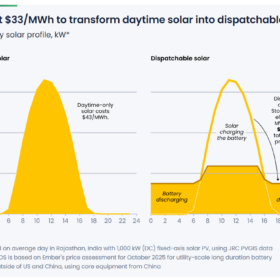From pv magazine Global
Most innovations that have impacted the falling price of solar systems over the last five decades have originated from outside the solar sector, according to research from the Massachusetts Institute of Technology (MIT).
The research paper “Nature of innovations affecting photovoltaic system costs,” available in the journal PLOS One, explores the specific innovations that have enabled significant cost reductions in solar panels.
The MIT team combined a quantitative cost model previously developed by the researchers with qualitative analysis of innovations that impacted the cost of PV system materials, manufacturing steps and deployment processes. They identified 81 unique innovations that have impacted solar system costs since 1970, in which time solar panel costs have fallen by over 90%.
Highlighted innovations include advances in semiconductor fabrication, metallurgy, glass manufacturing, oil and gas drilling and construction processes. Most innovations included in the sample impact hardware, but the research paper adds that some innovations have also targeted software technologies, such as developments in fast-track permitting.
“PV was very well-positioned to absorb innovations from other industries – thanks to the right timing, physical compatibility, and supportive policies to adapt innovations for PV applications,” commented Magdalena Klemun, one of the research’s contributors.
The research paper highlights that there are differences in the innovations that have reduced the cost of solar modules, compared to innovations that have influenced balance of system (BoS) costs.
While innovations reducing module costs include the advancement of manufacturing tools and module quality, BoS innovations reduced costs through component design changes, integration, automation, digitalization and standardization. The research also points out that most solar panel innovations have originated in research organizations or industry, while many BoS innovations were developed by city governments, U.S. states, or professional associations.
In the research paper, the team says their framework analysis helps to provide insight into the knowledge spillovers between technologies. “Both module and BoS hardware innovations show the benefits of PV’s position within an ‘ecosystem’ of continuously advancing technologies in many industries, in particular semiconductors and electronics, and also point to the importance of public institutions for accelerating testing, permitting, and training,” they explain.
The team has also considered the role that greater computing power could play in reducing BoS costs further, through advances including automated engineering review systems and remote site assessment software, as well as the developing role of robotics and AI-driven digital tools.
“In terms of knowledge spillovers, what we’ve seen so far in PV may really just be the beginning,” Klemun added.
This content is protected by copyright and may not be reused. If you want to cooperate with us and would like to reuse some of our content, please contact: editors@pv-magazine.com.







By submitting this form you agree to pv magazine using your data for the purposes of publishing your comment.
Your personal data will only be disclosed or otherwise transmitted to third parties for the purposes of spam filtering or if this is necessary for technical maintenance of the website. Any other transfer to third parties will not take place unless this is justified on the basis of applicable data protection regulations or if pv magazine is legally obliged to do so.
You may revoke this consent at any time with effect for the future, in which case your personal data will be deleted immediately. Otherwise, your data will be deleted if pv magazine has processed your request or the purpose of data storage is fulfilled.
Further information on data privacy can be found in our Data Protection Policy.